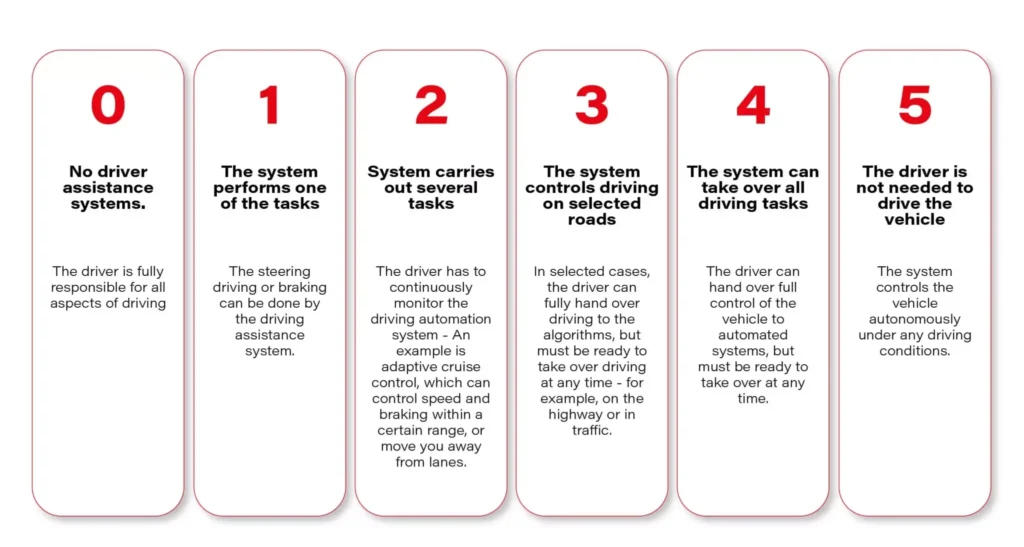
Tesla has Autopilot, Cadillac has Tremendous Cruise, and Audi makes use of Journey Help. Whereas there are various names, their performance is actually comparable. ADAS(superior driver-assistance techniques) assists the driving force whereas on the highway and units the trail we have to take towards autonomous driving. And the place does your model rank when it comes to automobile automation?
Shoppers’ Experiences knowledge exhibits that 92 p.c of latest vehicles have the power to automate pace with adaptive cruise management, and 50 p.c can management each steering and pace. Though we’re nonetheless two ranges away from a automobile that shall be absolutely managed by algorithms (see the infographic beneath), which, in keeping with unbiased consultants, is unlikely to occur inside the subsequent 10 years (no less than in the case of conventional automobile site visitors), ADAS techniques are discovering their approach into new automobiles 12 months after 12 months, and drivers are slowly studying to make use of them properly.

On the six-step scale of car automation – beginning at degree 0, the place the automobile shouldn’t be outfitted with any driving know-how, and ending at degree 5 (absolutely self-driving automobile) – we are actually at degree 3. ADAS techniques, that are in a approach the muse for a totally automated automobile, mix automated driving, acceleration, and braking options underneath one roof.
Nonetheless, to ensure that this pattern to be adopted by the market and develop dynamically 12 months by 12 months, we have to concentrate on useful software program and the challenges dealing with the automotive trade.
The principle threats dealing with automated driving help techniques
1. The absence of a driver monitoring system
Effectively-designed for performance and UX, ADAS can successfully scale back driver fatigue and stress throughout prolonged journeys. Nonetheless, for this to occur it must be outfitted with an efficient driver monitoring system.
Why is that this vital? With the switch of some driving accountability into the fingers of superior know-how, the temptation to “thoughts their very own enterprise” can come up within the driver. And this typically leads to drivers scrolling by way of their social media feeds on their smartphones. When automating driving, it is very important contain the driving force, who have to be consistently conscious that their presence is crucial to driving.
In the meantime, Shopper Experiences, which surveyed dozens of such techniques in automobiles from main producers, reviews that simply 5 of them: BMW, Ford, Tesla, GM and Subaru – have fitted ADAS with such know-how.
In response to William Wallace – security coverage supervisor at Shopper Experiences, “The proof is obvious: if a automobile facilitates individuals’s distraction from the highway, they’ll do it – with probably deadly penalties. It’s important that energetic driving help techniques have security options that really confirm that drivers are paying consideration and are able to take motion always. In any other case, the protection dangers of those techniques might in the end outweigh their advantages.”
2. Lack of response to surprising conditions
In response to the identical establishment, not one of the techniques examined reacted effectively to unexpected conditions on the highway, akin to building, potholes, or harmful objects on the roadway. Such deficiencies in performance in present techniques, subsequently, create a possible danger of accidents, as a result of even when the system guides the automobile flawlessly alongside designated lanes (intermittent lane-keeping or sustained lane-keeping system) the automobile is not going to warn the driving force in time to take management of the automobile when it turns into essential to readjust the route.
There are already present options available on the market that may successfully warn the driving force of such occurrences, considerably enhance driving consolation and “delegate” some duties to clever software program. These are undoubtedly additional parts on the listing of issues price upgrading driving automation techniques inside the coming years.
3. Insufficient UX and non-intuitive person expertise
All technological improvements originally of their improvement breed resistance and misunderstanding. It’s as much as the producer and the businesses growing software program to help automobile automation to create techniques which are simple and user-friendly. Having easy controls, clear shows and clear suggestions on what the system does with the automobile is an absolute “must-have” for any system. The driving force wants to grasp proper from the outset during which conditions the system needs to be used when to take management of the automobile and what the automation has to supply.
4. Lack of consistency in symbols and terminology
Understanding the advantages and performance of ADAS techniques is definitely not made simpler by the shortage of market consistency. Every of the main automobile producers makes use of completely different terminology and symbols for displaying warnings in automobiles. The client of a brand new automobile doesn’t know if a system named by Toyota affords the identical advantages as a very completely different named system obtainable from Ford or BMW and the way far the automation goes.
Sensory overload impacts driver frustration, misunderstanding of automation, or outright resentment, and that is mirrored in shopper buying selections and, thus, within the improvement of techniques themselves. It’s difficult to trace their influence on security and driving comfort when the trade has not developed uniform naming and constant labeling to assist implement the mandatory security options and elements of such techniques.
5. System errors
Automation techniques in passenger vehicles are pretty new and nonetheless in improvement. It’s pure that within the early levels they will make errors and typically draw the unsuitable conclusions from the conduct of drivers or neighboring automobiles. Sadly, errors – like those listed beneath – trigger drivers to disable elements of the system and even all of it as a result of they merely don’t know easy methods to cope with it.
- Lane-keeping assists freaking out in poorer climate;
- Steering stiffening and robotically slowing down when attempting to cross the road;
- Sudden acceleration or braking of a automobile with energetic cruise management – akin to throughout overtaking maneuvers or getting into a curve on a freeway exit or misreading indicators on truck trailers.
Methods to keep away from such errors? The answer is to develop extra correct fashions that detect which lanes are affected by indicators or site visitors lights.
Automobile automation can’t occur robotically
Contemplating the variety of potential challenges and dangers that automakers face when automating automobiles, it’s clear that we’re solely originally of the highway to the widespread adoption of those applied sciences. It is a defining second for his or her additional improvement, which lays the muse for additional motion.
On the one hand, drivers are already starting to belief them, use them with larger frequency, and anticipate them in new automobile fashions. Then again, many of those techniques nonetheless have the standard flaws and shortcomings of “infancy,” which signifies that with their misunderstanding or overconfidence of their capabilities, driver frustration may result, or in excessive instances, accidents. The function of automotive OEMs and software program builders is to create options which are easy and intuitive and to take heed to market suggestions much more attentively than earlier than. A gradual introduction of such options to the market, so that buyers have time to be taught and grasp them, will definitely facilitate automation to a larger extent and in the end the creation of absolutely automated automobiles. For now, the trail resulting in them remains to be lengthy and bumpy.








